This post is targeted to see and learning about the creation of an Audit Process Creation Policy Using Intune. We will enable the Audit Process Creation Policy Using Intune. To enable this Policy, we will use the Configuration Profiles from Intune.
Audit Process Creation Policy Using Intune determines the level of detail logged in security audit events when a new process is created. It is applicable only when the Audit Process Creation policy is enabled. Enabling this policy setting will result in the logging of command line information for each process in plain text within the security event log.
This information will be included as part of the Audit Process Creation event 4688, which indicates the creation of a new process. This policy setting is effective on workstations and servers where it is applied. If you disable or leave this policy setting unconfigured, the command line information of processes will not be included in the Audit Process Creation events.
The default setting for this policy is “Not configured.” It’s important to note that when this policy is enabled, any user with access to read the security events will be able to view the command line arguments of any successfully created process. As command line arguments may contain sensitive or private information like passwords or user data, caution should be exercised when enabling this policy.
Overall, this policy setting provides granular control over the level of detail captured in security audit events related to process creation. Still, it should be implemented with caution and considering the sensitivity of the command line arguments involved.
Windows CSP Details IncludeCmdLine
Let’s go through Windows CSP Details for this Policy setting IncludeCmdLine. The policy setting mentioned is specifically designed to control the level of information logged in security audit events related to process creation. When the “Audit Process Creation” policy is enabled, this setting comes into effect. To mitigate the risks associated with enabling this policy, it is crucial to carefully assess the access permissions for reading security events and ensure that only authorized individuals or entities have access to such information.
CSP URI – ./Device/Vendor/MSFT/Policy/Config/ADMX_AuditSettings/IncludeCmdLine

Audit Process Creation Policy Using Intune
To create Audit Process Creation Policy Using Intune, follow the steps stated below:
- Sign in to the Intune Admin Center portal https://intune.microsoft.com/.
- Select Devices > Windows > Configuration profiles > Create a profile.
In Create Profile, Select Windows 10 and later in Platform, and Select Profile Type as Settings catalog. Click on Create button.
| Platform | Profile Type |
|---|---|
| Windows 10 and later | Settings Catalog |
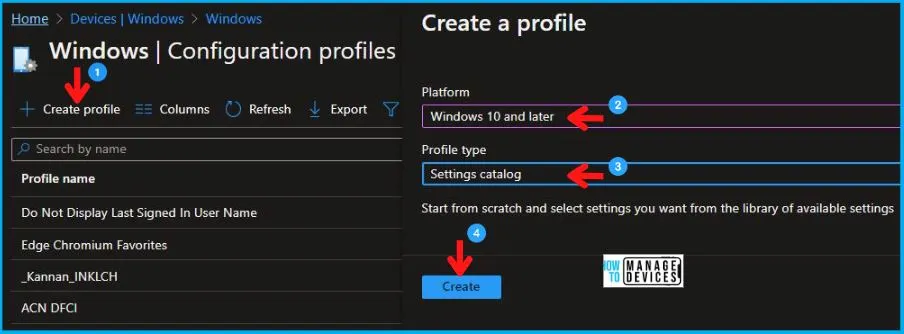
On the Basics tab pane, provide a name for the policy as “Audit Process Creation Policy.” Optionally, you can enter a description for the policy, and then proceed by selecting “Next.”
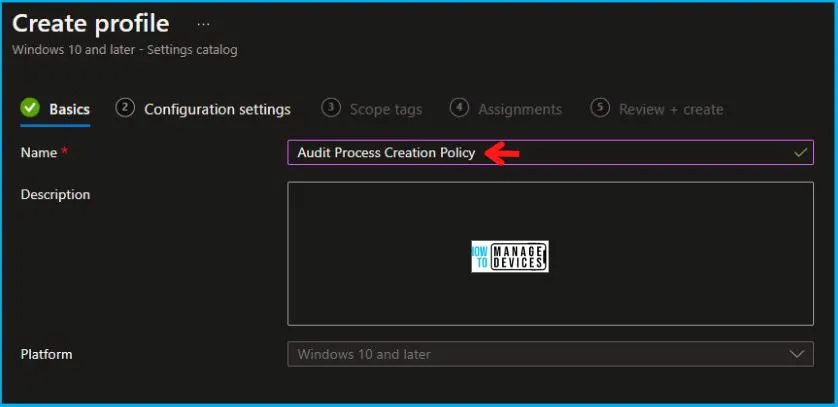
Now in Configuration settings, click Add Settings to browse or search the catalog for the settings you want to configure.
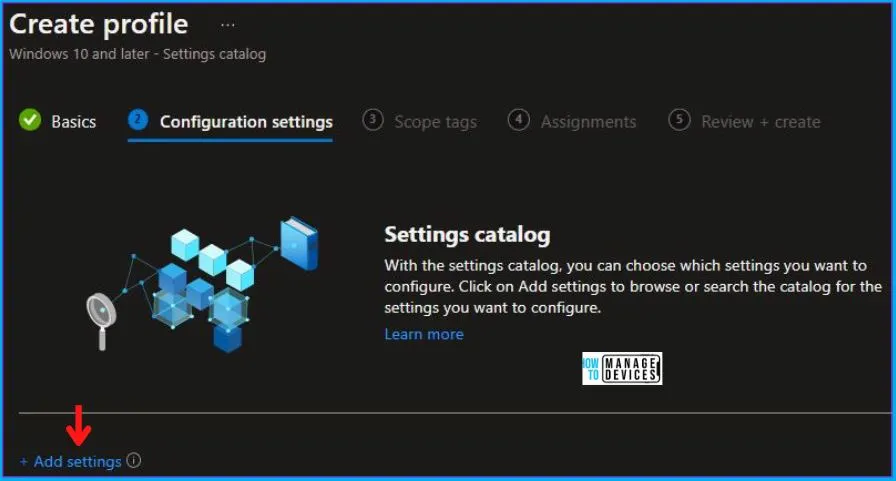
In the Settings Picker windows, search by the keyword Audit Process, among two, you will see Administrative Templates\System\Audit Process Creation, and select this.
When you select the option as stated above, you will see only one setting, which is Include command line in process creation events. After selecting your setting, click the cross mark at the right-hand corner, as shown below.
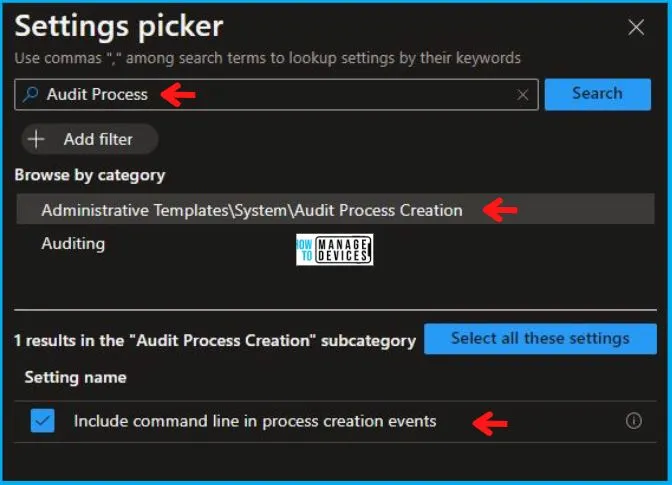
Now, in the Administrative Templates, Enabled the Include command line in process creation events, as shown below in the image.
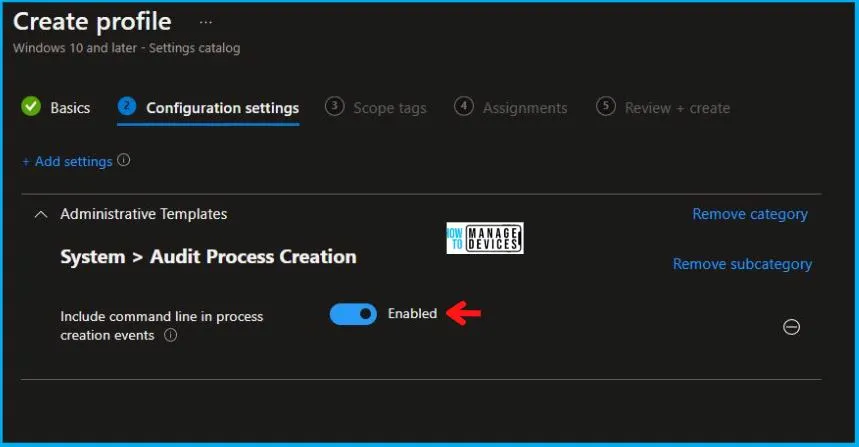
Using Scope tags, you can assign a tag to filter the profile to specific IT groups. One can add scope tags (if required) and click Next to continue. Now in Assignments, in Included Groups, you need to click on Add Groups, choose Select Groups to include one or more groups, and click Next to continue.
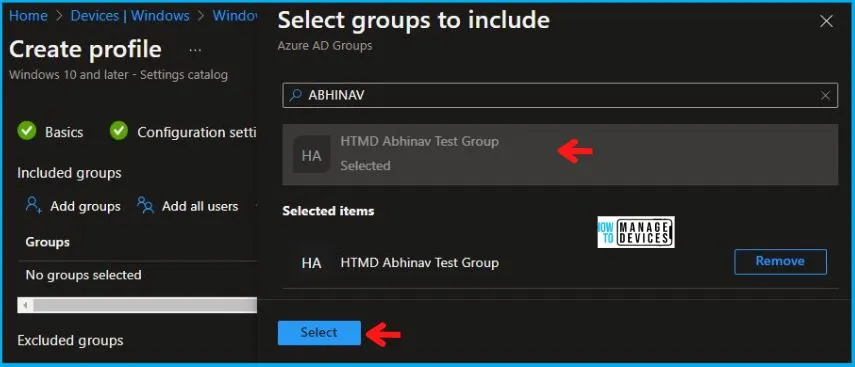
In the Review + Create tab, you need to review your settings. After clicking on Create, your changes are saved, and the profile is assigned.
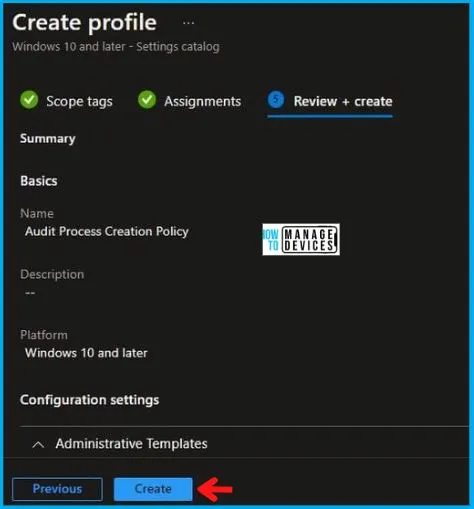
An automatic notification will be displayed in the top right-hand corner to indicate the successful creation of the “Audit Process Creation Policy.” Additionally, you can verify its presence by checking the Configuration Profiles list, where the policy will be clearly visible.
Your groups will receive your profile settings when the devices check in with the Intune service. The Policy applies to the device.
Intune Report for Audit Process Creation Policy Using Intune
From Intune Portal, you can view the Intune settings catalog profile report, which provides an overview of device configuration policies and deployment status.
To monitor the assignment of the policy, you must choose the appropriate policy from the list of Configuration Profiles. You can check the device and user check-in status to see if the policy has been successfully applied. If you wish to view more information, you can click on “View Report” to see additional details.
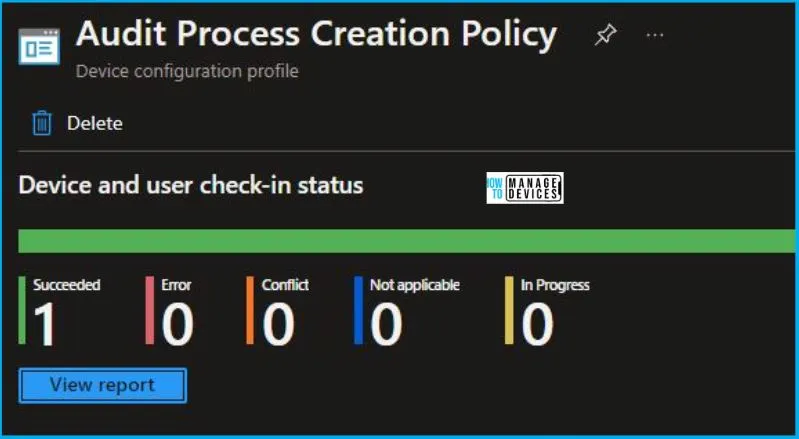
Intune MDM Event Log
To ascertain the successful application of String or integer policies on Windows 10 or 11 devices using Intune, event IDs 813 and 814 can be utilized. By analyzing these event IDs, you can identify both the policy’s application status and the specific value associated with the applied policy on those devices. For this specific policy, the value is a string and is associated with event ID 814.
To confirm this, you can check the Event log path – Applications and Services Logs – Microsoft – Windows – Devicemanagement-Enterprise-Diagnostics-Provider – Admin.
MDM PolicyManager: Set policy string, Policy: (IncludeCmdLine), Area: (ADMX_AuditSettings), EnrollmentID requesting merge: (4009A089-4FBA-482B-9D17-9E5A8428CB98), Current User: (Device), String: (<enabled/>), Enrollment Type: (0xD), Scope: (0x0).
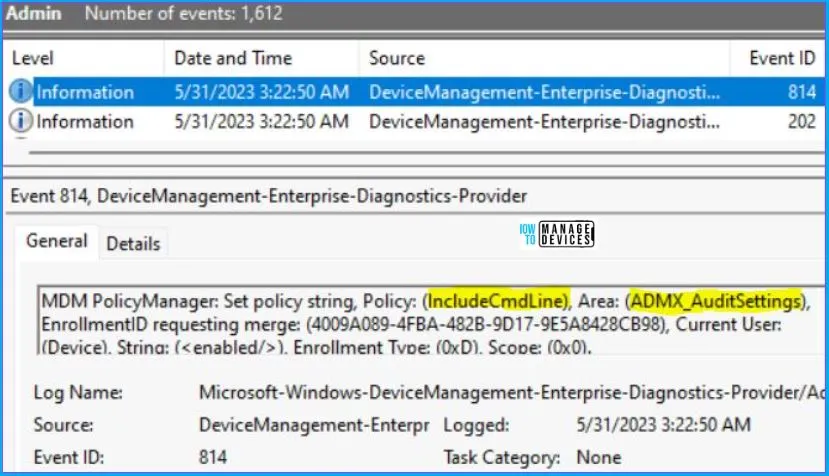
Upon examining the above-mentioned log in the Event Viewer, you will discover crucial details such as the Area and Enrollment ID. These pieces of information are instrumental in identifying the registry path. To find the relevant information, kindly refer to the table provided below:
| Area | Policy | String | Scoped | Event ID |
|---|---|---|---|---|
| ADMX_AuditSettings | IncludeCmdLine | Enabled | Device | 814 |
The information provided in the above table for Audit Process Creation Policy Using Intune can be utilized to access the registry settings storing group policy configurations on a target computer. By running “REGEDIT.exe” on the target computer, you can navigate to the specific registry path where these settings are stored.
- Computer\HKEY_LOCAL_MACHINE\SOFTWARE\Microsoft\PolicyManager\providers\4009A089-4FBA-482B-9D17-9E5A8428CB98\default\Device\ADMX_AuditSettings
When you navigate to the above path in the Registry Editor, you will find the registry key with the name IncludeCmdLine. Refer to the table and image below.
| Registry Name | Value |
|---|---|
| IncludeCmdLine | Enabled |

Author
Abhinav Rana is working as an SCCM Admin. He loves to help the community by sharing his knowledge. He is a B.Tech graduate in Information Technology.
